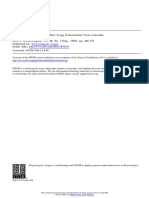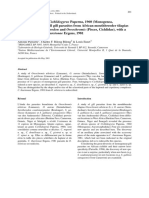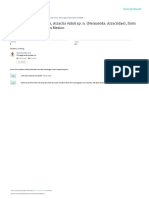Schizomid Fauna
Schizomid Fauna
Uploaded by
Ion BurcovskiCopyright:
Available Formats
Schizomid Fauna
Schizomid Fauna
Uploaded by
Ion BurcovskiOriginal Description:
Original Title
Copyright
Available Formats
Share this document
Did you find this document useful?
Is this content inappropriate?
Copyright:
Available Formats
Schizomid Fauna
Schizomid Fauna
Uploaded by
Ion BurcovskiCopyright:
Available Formats
Arachnologische Mitteilungen 38: 1-3
Nrnberg, Dezember 2009
Stenochrus portoricensis new to the Czech Republic (Schizomida, Hubbardiidae)
Stanislav Korenko, Mark Harvey & Stano Pekr
Abstract: A schizomid, Stenochrus portoricensis Chamberlin, 1922 (family Hubbardiidae), was collected in a greenhouse in Brno. This is the rst discovery of a schizomid from the Czech Republic.
Key words: Faunistics, greenhouse, introduced species
The named world schizomid fauna comprises 38
genera and 218 species, but numerous species from
many parts of the world have yet to be described
(HARVEY 2003). In nature schizomids are exclusively
known from tropical and subtropical regions, but three
species have been recorded from greenhouses in Europe: Schizomus crassicaudatus (O. P.-Cambridge, 1872)
from Sri Lanka was imported to France and Zomus
bagnallii ( Jackson, 1908) from South-east Asia was
introduced to Great Britain (BLICK 2006). Recently,
we collected Stenochrus portoricensis Chamberlin,
1922 within a greenhouse in the Czech Republic.
Stenochrus portoricensis naturally occurs in Mexico
and the Caribbean (ROWLAND & REDDELL 1980,
MARTN & OROM 1984, REDDELL & COKENDOLPHER 1995, TOURINHO & KURY 1999), but
has been accidentally introduced into many countries
of North and South America (Brazil, Ecuador and
Florida) and even in Europe: Spain (Canary Islands
politically, but not geographically, a part of Europe),
Great Britain and Germany (BLICK 2006, COKENDOLPHER et al. 2006). In continental Europe, the
species occurs only in heated greenhouses, whereas
the Canary Islands populations came from caves and
inside houses (MARTN & OROM 1992, OROM &
MARTN 1992).
Stenochrus portoricensis Chamberlin, 1922
Diagnosis and description: From the other two
schizomid genera (Zomus and Schizomus) found in
Europe, Stenochrus is distinguished by the combiStanislav KORENKO & Stano PEKR, Department of Botany and
Zoology, Faculty of Sciences, Masaryk University, Kotlsk 2,
611 37 Brno, Czech Republic, E-Mail: pekar@sci.muni.cz
Mark HARVEY, Department of Terrestrial Zoology, Western
Australian Museum, Locked Bag 49, Welshpool DC, Western
Australia 6986, Australia
eingereicht: 13.7.2009, akzeptiert: 7.8.2009; online verfgbar: 1.9.2009
nation of the following characters: female agellum
with three segments (Fig. 1), anterior process of
propeltidium with only one pair of setae arranged
one behind the other (Fig. 2), metapeltidium entire
(Fig. 2), movable cheliceral nger without accessory
teeth (Fig. 3), and by a mesal spur on the trochanter
of the pedipalp (Fig. 4).
Stenochrus portoricensis can be distinguished from
other species of the genus by the characters of the
internal genitalia of females (see ROWLAND & REDDELL 1980, figs 46-53; SANTOS et al. 2008, fig. 8).
Detailed diagnoses and descriptions can be found in
ROWLAND & REDDELL (1980), TOURINHO & KURY
(1999), ARMAS (2004) and SANTOS et al. (2008).
Material
Greenhouse, Botanical Garden of the Masaryk University,
310 m a.s.l., Brno (4912'17"N, 1635'47"E), 22 October
2008, 1, 1 juv , leg. S. Korenko; same site, 15 January
2009, 2, 1 juv , leg. S. Korenko, E. Lznarov & L.
Sentensk; same site, 28. January 2009, 3, 2 juv ,
leg. S. Korenko, E. Lznarov & L. Sentensk; same site,
5, 4 juv , 5 February 2009 leg. S. Korenko & S.
Pekr (specimens lodged in the Masaryk University, Brno
and Western Australian Museum, Perth).
Natural History
We found specimens under pieces of bark lying on wet
soil. In America, S. portoricensis has been collected in
abandoned arboreal termite nests in a cocoa plantation
(SANTOS et al. 2008), termite and ant nests (REDDELL & COKENDOLPHER 1995), disturbed habitats
(TOURINHO & KURY 1999), caves (ROWLAND &
REDDELL 1980), and under rocks of an urbanised
beach and in litter in metropolitan Rio de Janeiro
(SANTOS et al. 2008).
In the laboratory specimens readily fed exclusively
on collembolans. In the greenhouse we found also thysanurans, ants and spiders in the litter so these might
be preyed upon too. SANTOS et al. (2008) found this
S. Korenko, M. Harvey & S. Pekr
Figs. 1-4: Female of Stenochrus portoricensis. 1. Flagellum (dorsal view). 2. Propeltidium with one pair of setae arranged one behind
the other (dorsal view). Arrows point to the position of setae. 3. Chelicerae (lateral view). 4. Right pedipalp (prolateral view).
Arrow points to the mesal spur of patella. Scales = 0.1 (A) and 0.2 (B-D) mm.
species within ant and termite nests, where it possibly
feeds on woodlice, collembolans, beetles, termites or
ants.
All collected specimens (N = 19) were juveniles or
females, suggesting that the population may be parthenogenetic. Males of this species are not commonly
collected (ROWLAND & REDDELL 1980, REDDELL
& COKENDOLPHER 1995, ARMAS 2004), and in
many parts of its range the species is presumably
facultatively parthenogenetic (REDDELL & COKENDOLPHER 1995). Stenochrus portoricensis might be
widely distributed in greenhouses throughout Europe;
therefore, faunistic surveys would be welcome.
Acknowledgements
We would like to thank M. Tup and M. Chytr for
their kind assistance in the Botanical Garden, and Eva
Lznarov and Lenka Sentensk for their help with collecting schizomids. This study was supported by grant no.
MSM0021622416 provided by the Ministry of Education,
Youth and Sports of the Czech Republic. SK was further
supported by grant no. 526/09/H025 from the Czech
Science Foundation.
References
ARMAS L.F. de (2004): Arcnidos de Repblica Dominicana. Palpigradi, Schizomida, Solifugae y Thelyphonida
(Chelicerata: Arachnida). Revista Ibrica de Aracnologa, vol. esp. 2: 1-63
BLICK T. (2006): Zwerggeisselskorpione in Europa und
auf den Kanarischen Inseln. Internet: http://www.
theoblick.homepage.t-online.de/Schizomida.pdf
C OKENDOLPHER J.C., T. B LICK , H. B ELLMANN &
K. SCHRAMEYER (2006): Schizomida, short-tailed
whipscorpions (Arachnida) introduced into Europe
request for specimens, references & information.
Newsletter of the British Arachnological Society
107: 14
HARVEY M.S. (2003): Catalogue of the smaller arachnid
orders of the world: Amblypygi, Uropygi, Schizomida,
Palpigradi, Ricinulei and Solifugae. CSIRO Publishing,
Collingwood, Australia. 385 pp.
MARTN J.L. & P. OROM (1984): Consideraciones sobre
la presencia de Schizomus portoricensis Chamberlin,
1922 (Arach. Schizomida) en cuevas de Tenerife (Islas
Canarias). Boletn de la Sociedad Entomolgica de
Espaa 8: 265-270
Stenochrus portoricensis in the Czech Republic
OROM P. & J.L. MARTN (1992): The Canary Islands
subterranean fauna: characterization and composition. In: CAMACHO A.I. (ed.): The natural history of
biospeleology. Museo Nacional de Ciencias Naturales,
Madrid. Pp. 527-567
REDDELL J.R. & J.C. COKENDOLPHER (1995): Catalogue, bibliography and generic revision of the order
Schizomida (Arachnida). Texas Memorial Museum,
Speleological Monographs 4: 1-170
ROWLAND J.M. & J.R. REDDELL (1980): The order Schizomida (Arachnida) in the New World. III. Mexicanus
and pecki groups (Schizomidae: Schizomus). Journal of
Arachnology 8: 1-34
3
SANTOS A.J., S.C. DIAS, A.D. BRESCOVIT & P.A. SANTOS
(2008): The arachnid order Schizomida in the Brazilian
Atlantic Forest: a new species of Rowlandius and new
records of Stenochrus portoricensis (Schizomida: Hubbardiidae). Zootaxa 850: 53-60
TOURINHO A.L. & A.B. KURY (1999): The southernmost
record of Schizomida in South America, rst records
of Schizomida for Rio de Janeiro and of Stenochrus
Chamberlin, 1922 for Brazil (Arachnida, Schizomida,
Hubbardiidae). Boletim do Museu Nacional, N.S.
Zoologia 405: 1-6
You might also like
- A Guide To Green Infrastructure For Canadian Municipalities enDocument47 pagesA Guide To Green Infrastructure For Canadian Municipalities enIswatun HasanahNo ratings yet
- Potamites Montanicola 2012Document13 pagesPotamites Montanicola 2012Aleksandra PanyutinaNo ratings yet
- Baak Et Al New Records of Ectoparasites Echinolaelaps Echidninus and Polyplax Spinulosa On Rodents With Serological Evidence of Flavivirus InfecDocument11 pagesBaak Et Al New Records of Ectoparasites Echinolaelaps Echidninus and Polyplax Spinulosa On Rodents With Serological Evidence of Flavivirus Infecmelanieruiz09No ratings yet
- P Actites (Lynch, 1979)Document7 pagesP Actites (Lynch, 1979)Esteban Garzon FrancoNo ratings yet
- Cocceupodidae, A New Family of Eupodoid Mites, With Description of A New Genus and Two New Species From Poland. Part I. (Acari: Prostigmata: Eupodoidea)Document22 pagesCocceupodidae, A New Family of Eupodoid Mites, With Description of A New Genus and Two New Species From Poland. Part I. (Acari: Prostigmata: Eupodoidea)Je suis un MicaschisteNo ratings yet
- Bats of JordanDocument169 pagesBats of JordanBulentErdemNo ratings yet
- Tausan & Pintilioaie 2016Document4 pagesTausan & Pintilioaie 2016Ionut TausanNo ratings yet
- The Scorpionandits VenomDocument67 pagesThe Scorpionandits VenomGabriel FloreaNo ratings yet
- Morphology, Systematics, and Biology of The Spanish MackerelsDocument148 pagesMorphology, Systematics, and Biology of The Spanish MackerelsRio AlmusataNo ratings yet
- 2004 HeterometrusDocument62 pages2004 Heterometrusget aidsNo ratings yet
- Lynch.1982. Two New Species of Poison Dart Frogs - Edwardsi&ruiziDocument10 pagesLynch.1982. Two New Species of Poison Dart Frogs - Edwardsi&ruiziRaiza Nathaly Castañeda BonillaNo ratings yet
- Lewis Covell PDFDocument14 pagesLewis Covell PDFHernanFigueredoNo ratings yet
- ZootaxaDocument17 pagesZootaxaoliviamuliawatideviNo ratings yet
- Osteocephalus 3 SP Nov 2012Document52 pagesOsteocephalus 3 SP Nov 2012Aleksandra PanyutinaNo ratings yet
- 2017 - Isodontia Mexicana New To BritainDocument6 pages2017 - Isodontia Mexicana New To BritainAlexandra LvNo ratings yet
- tmpF37B TMPDocument2 pagestmpF37B TMPFrontiersNo ratings yet
- Jurnal Hideo Hasegawa OitaUniversityDocument12 pagesJurnal Hideo Hasegawa OitaUniversitymfft67f2sdNo ratings yet
- Filogenia de Avispas Del Género Netelia (Hymenoptera: Ichneumonidae) Con Énfasis en Las Especies CostarricensesDocument30 pagesFilogenia de Avispas Del Género Netelia (Hymenoptera: Ichneumonidae) Con Énfasis en Las Especies CostarricensesJames Coronado RiveraNo ratings yet
- Taxonomy, Distribution, and Notes On The Termites (Isoptera: Kalotermitidae, Rhinotermitidae, Termitidae) of Puerto Rico and The U.S. Virgin IslandsDocument21 pagesTaxonomy, Distribution, and Notes On The Termites (Isoptera: Kalotermitidae, Rhinotermitidae, Termitidae) of Puerto Rico and The U.S. Virgin IslandsHanifah HerliniNo ratings yet
- Decae 2010 Jou 38 328-340Document13 pagesDecae 2010 Jou 38 328-340Luis OsorioNo ratings yet
- 96 Arbea&Park 2015 Deuteraphorura KoreaDocument5 pages96 Arbea&Park 2015 Deuteraphorura KoreajarbeapoNo ratings yet
- Avicularia Rickwesti Sp. Nov., A Remarkable New Species of AviculariaDocument5 pagesAvicularia Rickwesti Sp. Nov., A Remarkable New Species of AviculariazzzaNo ratings yet
- Mantophasmatodea: A New Insect Order With Extant Members in The AfrotropicsDocument5 pagesMantophasmatodea: A New Insect Order With Extant Members in The AfrotropicsagccNo ratings yet
- A New Genus and Species of Grass SpecialDocument10 pagesA New Genus and Species of Grass SpecialElidiomar Ribeiro da SilvaNo ratings yet
- Marshal and Thornton 1963. MICROMALTHUS (Coleoptera - Micromalthidae) in Hong KongDocument6 pagesMarshal and Thornton 1963. MICROMALTHUS (Coleoptera - Micromalthidae) in Hong KongCarlos AguilarNo ratings yet
- Gustafson&Short 2010 BDocument11 pagesGustafson&Short 2010 BMauricio GarcíaNo ratings yet
- Ascidia World DataBaseDocument5 pagesAscidia World DataBasePatricia UntuNo ratings yet
- Paris Elle 2003Document10 pagesParis Elle 2003estebansulsNo ratings yet
- A New Species of Freshwater FL Atworm (Platyhelminthes, Tricladida, Dendrocoelidae) Inhabiting A Chemoautotrophic Groundwater Ecosystem in RomaniaDocument21 pagesA New Species of Freshwater FL Atworm (Platyhelminthes, Tricladida, Dendrocoelidae) Inhabiting A Chemoautotrophic Groundwater Ecosystem in RomaniaDanielaReteaNo ratings yet
- Artiodactyla and PerissodactylaDocument30 pagesArtiodactyla and PerissodactylaKalangiIrushikaNo ratings yet
- Entomology 322 Lab 2 Introduction To Arthropoda: HexapodaDocument10 pagesEntomology 322 Lab 2 Introduction To Arthropoda: HexapodaHumberto GiraldoNo ratings yet
- 44023-Article Text-138036-150338-10-20181227Document11 pages44023-Article Text-138036-150338-10-20181227Lara Caroline Carvalho RezendeNo ratings yet
- Akymnopellis Platei (Attems, 1903) (Scolopendromorpha: Scolopendridae)Document2 pagesAkymnopellis Platei (Attems, 1903) (Scolopendromorpha: Scolopendridae)Halisa IndrianiNo ratings yet
- Boldrini Et Al., 2017 (Brasil) BaDocument10 pagesBoldrini Et Al., 2017 (Brasil) Bacarmen villalobosNo ratings yet
- Unusual Looking Pentatomids: Reassessing The Taxonomy of Braunus Distant and Lojus McDonald (Hemiptera: Heteroptera: Pentatomidae)Document19 pagesUnusual Looking Pentatomids: Reassessing The Taxonomy of Braunus Distant and Lojus McDonald (Hemiptera: Heteroptera: Pentatomidae)bolosphex1634No ratings yet
- 1988 ClarkDocument44 pages1988 ClarkDiego MancillaNo ratings yet
- Tomix CyanopicaDocument8 pagesTomix CyanopicaIvan PavlovicNo ratings yet
- Florida Entomol. 2010Document4 pagesFlorida Entomol. 2010Daniel ZamoraNo ratings yet
- Acrosinophonia Algas - CHLOROPHYTADocument10 pagesAcrosinophonia Algas - CHLOROPHYTAdadette2009No ratings yet
- Clave Gráfica de Adultos de Los Geeros Hematofagos de Ceratopogonidae Presentes en La Region NeotropicalDocument15 pagesClave Gráfica de Adultos de Los Geeros Hematofagos de Ceratopogonidae Presentes en La Region NeotropicalLuis Paulo Costa CarvalhoNo ratings yet
- Molluscan Studies: Journal ofDocument19 pagesMolluscan Studies: Journal ofWidi SetyogatiNo ratings yet
- Salvo & Battan Horenstein 2008 Alysia AlticolaDocument4 pagesSalvo & Battan Horenstein 2008 Alysia AlticolaluzlunarNo ratings yet
- First Record in Iraq of Tanqua Anomala (Linstow, 1904) From The Dice Snake, Natrix Tessellata Tessellata (LAURENTI, 1768)Document12 pagesFirst Record in Iraq of Tanqua Anomala (Linstow, 1904) From The Dice Snake, Natrix Tessellata Tessellata (LAURENTI, 1768)Mohamad JakariaNo ratings yet
- Kostka 1991Document12 pagesKostka 1991Lola BoaNo ratings yet
- Prendinietal 2003 PDFDocument77 pagesPrendinietal 2003 PDFNona Hidayati MaghfirahNo ratings yet
- s11230 022 10027 7Document9 pagess11230 022 10027 7Camila PacoriNo ratings yet
- 2017 - New Evidence From China For The Nature of The Pterosaur Evolutionary TransitionDocument9 pages2017 - New Evidence From China For The Nature of The Pterosaur Evolutionary TransitionIsaacNo ratings yet
- A New Genus and Species of Scorpionfly (Mecoptera) From Baltic Amber, With An Unusually Developed Postnotal OrganDocument6 pagesA New Genus and Species of Scorpionfly (Mecoptera) From Baltic Amber, With An Unusually Developed Postnotal Organagnieszka.soszynska.majNo ratings yet
- Ursa in South America (Araneae: Araneoidea) : The Spider Genera Heterognatha, Testudinaria andDocument14 pagesUrsa in South America (Araneae: Araneoidea) : The Spider Genera Heterognatha, Testudinaria andJose Miguel TovarNo ratings yet
- Jolivet 2008 EumolpinaeDocument36 pagesJolivet 2008 EumolpinaeMarianela RoblesNo ratings yet
- Andia & Grismado - RevMACN - 17-1 - PaginadoDocument6 pagesAndia & Grismado - RevMACN - 17-1 - Paginadoaliciacardozo63No ratings yet
- Alytes, 16 (1-2), 61-67 - CrossodactylusDocument7 pagesAlytes, 16 (1-2), 61-67 - CrossodactylusSebas CirignoliNo ratings yet
- 26 GogaDocument7 pages26 GogaIryna ZapekaNo ratings yet
- Balint 2021 - Contributions To The Knowledge of Neotropical Lycaenidae Taxonomy of Johnsonita PDFDocument47 pagesBalint 2021 - Contributions To The Knowledge of Neotropical Lycaenidae Taxonomy of Johnsonita PDFFernando DiasNo ratings yet
- The Freshwater Decapod Crustaceans of Halmahera, IndonesiaDocument32 pagesThe Freshwater Decapod Crustaceans of Halmahera, IndonesiaEdward WangNo ratings yet
- Species New To Canada, With Notes On Other Non-Native SpeciesDocument15 pagesSpecies New To Canada, With Notes On Other Non-Native Speciesnanisah_10No ratings yet
- Dolej Vaousov 2015 AcollectionofhorseshoecrabsChelicerata XiphosuraintheNationalMuseumDocument10 pagesDolej Vaousov 2015 AcollectionofhorseshoecrabsChelicerata XiphosuraintheNationalMuseum2023102681No ratings yet
- Tachinidae (Diptera) Rearedfromclearwingmothsinslovenia (2007)Document4 pagesTachinidae (Diptera) Rearedfromclearwingmothsinslovenia (2007)Željko PredovnikNo ratings yet
- A New Atractid Nematode Atractis Vidali SP N Nemat PDFDocument5 pagesA New Atractid Nematode Atractis Vidali SP N Nemat PDFguillermo lopezNo ratings yet
- Delsuc-ProcRSocBS01 HALDocument37 pagesDelsuc-ProcRSocBS01 HALNicoleNo ratings yet
- Australian Dragonflies: A Guide to the Identification, Distributions and Habitats of Australian OdonataFrom EverandAustralian Dragonflies: A Guide to the Identification, Distributions and Habitats of Australian OdonataRating: 3 out of 5 stars3/5 (1)
- ColeopteraDocument92 pagesColeopteraIon BurcovskiNo ratings yet
- StrepsipteraDocument6 pagesStrepsipteraIon BurcovskiNo ratings yet
- Biodiversity (Annelida, Oligochaeta) in Different Aquatic Ecosystems of The Republic of MoldovaDocument6 pagesBiodiversity (Annelida, Oligochaeta) in Different Aquatic Ecosystems of The Republic of MoldovaIon BurcovskiNo ratings yet
- 07 Angio OriginDocument14 pages07 Angio OriginIon BurcovskiNo ratings yet
- Flowers and FruitsDocument14 pagesFlowers and FruitsIon Burcovski0% (1)
- Sea Transport: Impact On EnvironmentDocument20 pagesSea Transport: Impact On EnvironmentTahirah MohamedNo ratings yet
- Welcome 2 The Pearl of AfricaDocument2 pagesWelcome 2 The Pearl of AfricatartitaNo ratings yet
- First State National Park MapDocument6 pagesFirst State National Park MapPress_office0% (1)
- Africa FactbookDocument87 pagesAfrica Factbookmody_escu1897No ratings yet
- Bri OnesDocument12 pagesBri OnesOlan MalazzabNo ratings yet
- Community Succession Simulation: Surviving Drought: 2023 Mcm/Icm Summary SheetDocument25 pagesCommunity Succession Simulation: Surviving Drought: 2023 Mcm/Icm Summary Sheet251513144No ratings yet
- Presentation - Information Session BBNJ - 21-06-19Document26 pagesPresentation - Information Session BBNJ - 21-06-19bagusbagusNo ratings yet
- English Andal Amdal 2010 Part 1Document142 pagesEnglish Andal Amdal 2010 Part 1andriyani_wise7588100% (1)
- Environmental AssignmentDocument5 pagesEnvironmental AssignmentAlbert Francisco OstayaNo ratings yet
- Unit 2 - Mother Nature - Lesson ADocument12 pagesUnit 2 - Mother Nature - Lesson AQuỳnh AnhNo ratings yet
- Buku IMFBDocument112 pagesBuku IMFBlia LiaNo ratings yet
- Laporan Praktikum PerifitonDocument5 pagesLaporan Praktikum Perifitonchery rosyantiNo ratings yet
- Geoinformatics For Marine and Coastal ManagementDocument444 pagesGeoinformatics For Marine and Coastal ManagementFrancy Camila Vega Delgadillo100% (2)
- G.O.ms - No 156, E and F Dept. Dated 21.10.2010Document7 pagesG.O.ms - No 156, E and F Dept. Dated 21.10.2010Sushil Kumar Jangir100% (1)
- Wrd02 LEDsDocument3 pagesWrd02 LEDsDeon ConwayNo ratings yet
- PowerPoint Energy Flow in An EcosystemDocument22 pagesPowerPoint Energy Flow in An EcosystemmceldowneaNo ratings yet
- Acrylic Resin PodelaDocument7 pagesAcrylic Resin Podelaslavica_restauroNo ratings yet
- Method of IrrigationDocument6 pagesMethod of IrrigationKazi Shihab ShahriarNo ratings yet
- Science 5 - Q2 - W8Document6 pagesScience 5 - Q2 - W8Mathleen DescalzoNo ratings yet
- Science in Ohio Blizzard Bag 2Document6 pagesScience in Ohio Blizzard Bag 2api-239855791No ratings yet
- History of Environmental Law in IndiaDocument3 pagesHistory of Environmental Law in IndiaRUBINA KHANNo ratings yet
- Kuliah 1 Landscape ArchitectureDocument12 pagesKuliah 1 Landscape ArchitectureAmy RahimNo ratings yet
- Dormaster Residential and Commercial Services in Toronto Garage Door - Mississauga Garage Door - Garage Door Brampton - Garage Door Vaughan & GTADocument4 pagesDormaster Residential and Commercial Services in Toronto Garage Door - Mississauga Garage Door - Garage Door Brampton - Garage Door Vaughan & GTAPromaster Garage Doors Repair CanadaNo ratings yet
- 109 Ways To Conserve Water.Document8 pages109 Ways To Conserve Water.NellyNo ratings yet
- Advances in Composite Materials - Ecodesign and Analysis by Brahim AttafDocument654 pagesAdvances in Composite Materials - Ecodesign and Analysis by Brahim Attafmenonarjun7No ratings yet
- English Year 5 Paper 2 Summative Exam 1 2021Document7 pagesEnglish Year 5 Paper 2 Summative Exam 1 2021jccoccnNo ratings yet
- 15862-Article Text-44437-2-10-20201028Document7 pages15862-Article Text-44437-2-10-20201028Diroy ParulianNo ratings yet
- MANUSCRIPT1Document55 pagesMANUSCRIPT1Lonica Shane Buat CamilloNo ratings yet
- Vocabulary Test 1 - (Unit 1)Document4 pagesVocabulary Test 1 - (Unit 1)Alisha NisrinaNo ratings yet






























































































